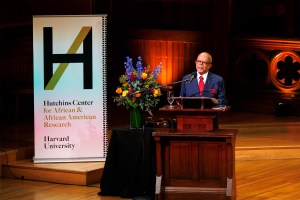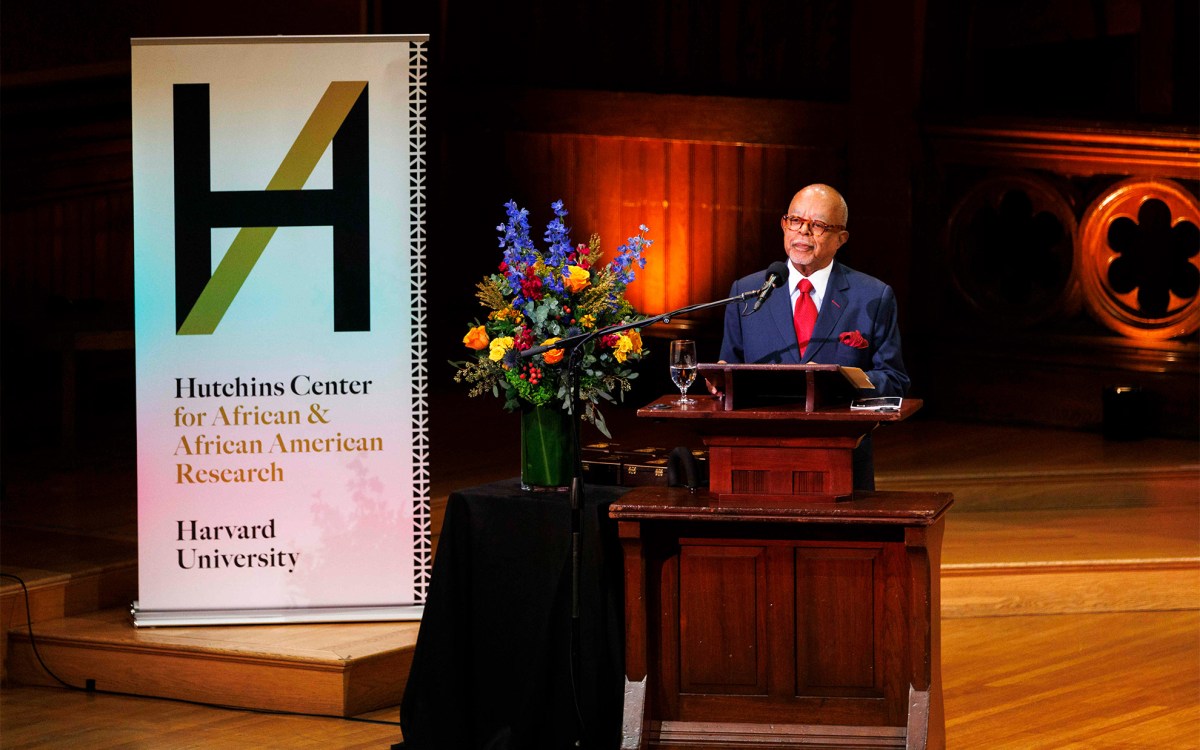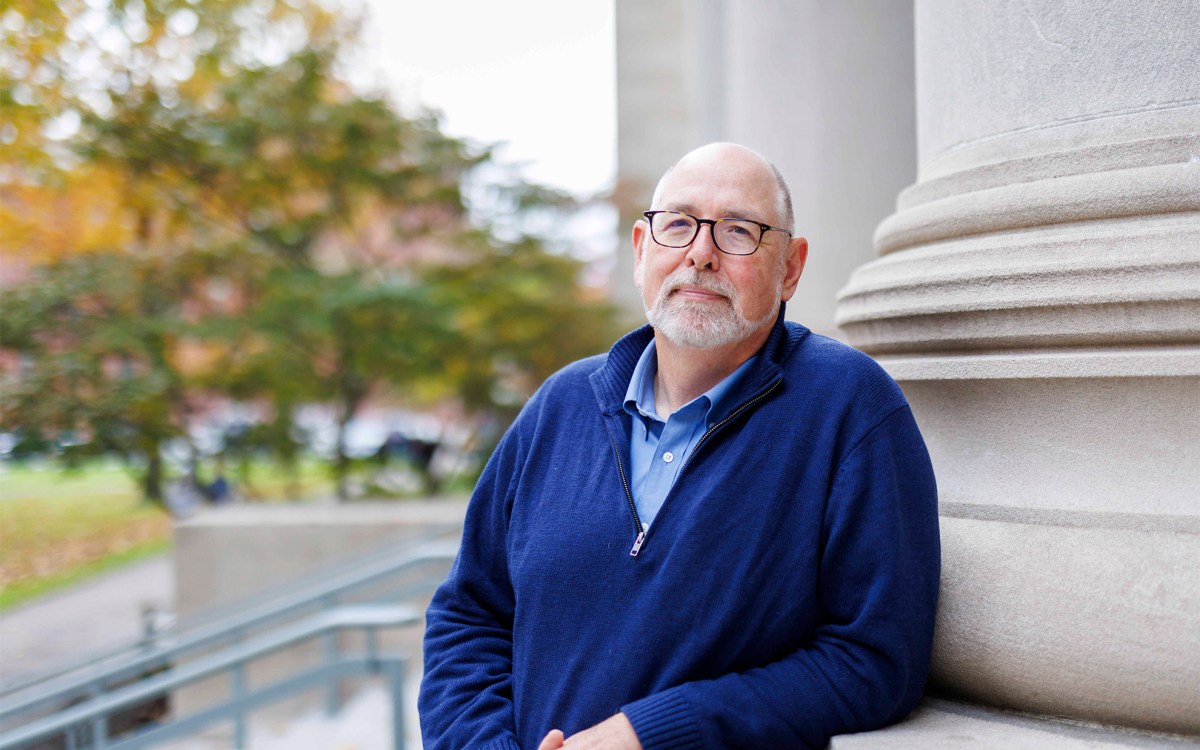
Harvard Law School Dean Martha Minow and Harvard Law Professor Noah Feldman speak about the current supreme court with the Harvard Gazette. Martha Minow (pictured) and Noah Feldman speak in Griswold Hall at Harvard University. Stephanie Mitchell/Harvard Staff Photographer
Photos by Stephanie Mitchell/Harvard Staff Photographer
The Supreme Court’s new dynamic
Law School leaders gauge debut of former colleague Elena Kagan, and the import of upcoming cases
The U.S. Supreme Court is beginning its fall session with a new member, former Harvard Law School Dean Elena Kagan. Current Dean Martha Minow, who was both a teacher and a colleague to Kagan, and Noah Feldman, the Bemis Professor of International Law, who clerked at the Court and follows its proceedings closely, met with the Gazette to discuss the upcoming judicial year.
GAZETTE: Let’s begin by talking about the newest member of the court.
FELDMAN: In whose recently past office we sit.
GAZETTE: Exactly. Now that she’s about to start in her new role, how do you think she will change the dynamic on the court?
MINOW: I think she will change the dynamic on the court, but its actual direction we won’t know for several years. It’s also true that not only is she present, but Justice [John Paul] Stevens is absent, and so those are two major changes all at once. The consequence of that, we know immediately, will be relevant to conference discussions, also relevant to the assignment of opinions. She will not step into the role that he had because he was senior. On the other hand, she has terrific relationships with members on the court. She has gifts that we know firsthand: gifts of persuasion and knowing when to listen and when to speak. That’s why I say she will have a big influence, but we may not see it this year.
FELDMAN: There’s also a quirk, which is that because she was previously solicitor general, she can’t sit on a large number of cases. This really matters a lot because there are an odd number of justices. If you subtract one, you get a split court, and this court is often deeply divided on very controversial issues.
MINOW: In talking about Justice Kagan, it’s hard to restrict ourselves to this term because she’ll be there, we hope, for decades. This term will be an anomaly in terms of the small number of cases that she’ll actually be able to vote on.
GAZETTE: I wanted to step back for a moment to Commencement, when retired Justice David Souter offered a rather remarkable address. He contrasted the views of jurists who follow what he called the “fair reading” model with a judicial philosophy that requires justices to bring contemporary values to bear on constitutional questions before the court. How can his remarks inform casual court observers — people who just follow the workings of the court in the daily newspaper or on TV?
MINOW: Let’s look to the former Souter clerk. …
FELDMAN: Well, I’m speaking now, obviously, for myself and not Justice Souter. But I think that the general observer of the court should see — and Justice Souter wanted us, I believe, to see — that there is no purely neutral way of deciding difficult constitutional cases, that it’s not the case that, well, if you just figure out what the Founding Fathers wanted, you’ll have the answer, and we’ll know neutrally what needs to be done.
It’s not that there is a neutral role and an activist role. In fact I think he was precisely rejecting that view. He was trying to tell you that the Constitution itself in many cases — not in every case, but in many important cases — doesn’t answer the question without human beings bringing their values to the table.
Now they should look, he said, to the Constitution to identify those values. But he was acknowledging that different people acting in good faith could read the Constitution and come up with different values.
To me, the most profound thing that he said was that the American people, like most people, like to have it both ways. We want liberty and security. We want equality and to take account of past wrongs. And he was suggesting, I think, that having it both ways was embedded in the Constitution from the start, and that it’s the reason that, in many difficult cases, you can’t avoid the value choices between different competing visions of the right way to arrange the country.
GAZETTE: Let’s talk about some of the significant cases coming up this session.
MINOW: Well, we can identify the hot issues. But in terms of what will be
influential, both for the judiciary and for the country, I don’t think we know yet.
A couple of years ago, the Court decided what looked like a very technical case — Ashcroft v. Iqbal — about how specific the complaint has to be to launch a federal lawsuit. That has ended up being one of the most important cases, I think, in some time. It has transformed the power of judges to control what litigation goes forward.
FELDMAN: Let’s talk about themes. The first has to do with the question of what kind of rights do corporations have? Do corporations have constitutional rights?
In a case called Citizens United, which has gotten a lot of attention recently, the Supreme Court essentially held that, when it came to free speech rights, corporations would be treated more or less like individuals, a result that had far-reaching consequences.
Now, the court has always treated corporations as having some limited rights for some purposes, but this was a much more extensive expansion.
GAZETTE: This is the political money case, right?
FELDMAN: That was the political money case. Now, this term, the court is going to ask whether, under a federal statute — not under the Constitution, but under a federal statute — corporations should be treated as having personal privacy. The statute uses the words “personal privacy.” Now again, it’s not exactly the same issue because it’s not about the constitutional rights of corporations but about the statutory rights of corporations, which is a lawyers’ distinction, but it matters. But the court has to address this question of: Do you treat a corporation as something special? Or do you treat a corporation as though it were a human being?
I think that is a theme that we’re going to see lots of over the next several years. The deeper theme that it connects to is the theme of corporate power and this court. Will the Roberts Court continue a trend in which they’ve extended corporate power in the face of federal legislation that has sought to limit or restrict federal power?
A second theme that I think is significant is, broadly speaking, the question of national security and how far the government has to go to justify the things that it does as a matter of national security when it appears in a court of law. And there’s been a lot of attention to this question since September 11.
The case that’s most salient in dealing with these issues this term has to do with state secrets. This is a doctrine of the Supreme Court, which doesn’t appear anywhere in the Constitution, that says, sometimes, if you sue the government and the government says, “There’s a state secret at issue here, we don’t even want to answer your complaint.” You say that “We passed you off to Syria, where you were tortured.” The government wants to say, “Sorry, we won’t acknowledge or deny. This implicates state secrets. Go away.”
And there are a couple of cases that the court just granted that are going to deal with this issue — not in the case of anyone who was allegedly tortured — but in cases involving defense contractors who are raising the state secrets doctrine [General Dynamics Corp. v. U.S. and Boeing Co. v. U.S.].
The last thing I was going to talk about is the First Amendment. But I’ll let the dean weigh in.
MINOW: There is a very poignant and difficult First Amendment case coming up before the court, which presents a conflict between speech and religion because, in this case, there were protesters who disrupted — allegedly, but certainly did protest — a funeral service for a soldier who was killed in Iraq — Snyder v. Phelps. And the family members sued individuals — members of a church group who have made it a practice of protesting at military funerals as a way of asserting that God is punishing America because of its tolerance for homosexuality, especially in the military. A district court awarded money damages to the family of the deceased soldier. The court of appeals reversed and said the protesters’ speech was protected. Some 40 senators and many state attorneys general have weighed in. This is a hotly contested and very, very challenging case.
There is another free speech case, in which the court will consider whether freedom of speech invalidates a state statute that prohibits the rental of violent video games to minors. This issue has been percolating through the states for some years now, and the case [Schwarzenegger v. EMA] has attracted 27 friend-of-the court briefs.
I’ve had former students who are working for governors in two states call me and say: Could I advise them on how to draft a law to regulate the sale of violent video games so that minors cannot obtain them? I’ve looked at their draft language. I’ve tried to write draft language. I can’t come up with one that will survive First Amendment review under the doctrine that the Supreme Court has developed up to now. It’ll be extremely interesting to me to see whether the court comes up with a new line that will permit this kind of regulation.
FELDMAN: It’s going to be a good First Amendment term. Another really interesting First Amendment case is an issue that’s really very much in Dean Minow’s direct expertise, so maybe she’ll speak about it as well. And that is a comparative case that’s coming out of Arizona [Arizona Christian School Tuition Organization v. Winn, and Garriott v. Winn] about a state tuition tax credit that is used, statistically, more by parents who send their children to religious or parochial schools. And that is being challenged in two modes.
The actual program is being challenged as unconstitutional and, in addition, there is the question of whether parents have the right to actually go to the Supreme Court and ask for a hearing, which has become a hot issue. It sounds obscure, but it’s become a hot issue in cases about the expenditure of government money on religious purposes.
MINOW: It is indeed a fascinating case. And it really puts to the court this issue of who may raise objections about the uses of public dollars, just shortly following a case by the court where they curbed the ability of private individuals to bring such suits [Hein v. Freedom from Religion Foundation]. My prediction is that many of the justices will want to deny standing here too. But if the court does reach the merits, this is a court — or at least some members of the court have looked favorably upon the use of public dollars to support the private selection of private religious schools. And so in some sense the two parts of this case point in opposite directions.
There’s another religion case pending this year that also raises the question of when can a suit proceed, and this is the case of Sossamon v. Texas. In this case, an inmate has sued the state of Texas and a prison warden. The inmate claimed that he was not allowed to have access to the prison chapel and that that violates a federal statute, which, he claims, should give rise to money damages. The statute itself was an effort by Congress, in a long-running conflict with the court, to assert more protection for religious freedom than the court had been willing to do.
There are some cases that are pending that may look very technical but are truly important. There’s a doctrine — again that’s on this level of structure of government: Who decides — that’s called preemption, in which the federal government can say the states do not have a say in certain areas. We know that, in many, many areas, that decision — whether or not the states can have a say — will be enormously important, whether it’s abortion or same-sex marriage or, increasingly, the protections for consumers.
This particular case [Bruesewitz v. Wyeth] deals with childhood vaccines, so this is the National Childhood Vaccine Injury Act that’s involved. In this case, some parents claim that their daughter became ill, developed a disorder after she obtained a vaccine. The statute preempts certain claims against vaccine manufacturers. This is a hot issue, particularly if you’re a parent of young children.
The specific question is whether or not Congress did prevent suits even where the injury from the vaccines is preventable.
FELDMAN: We should add, just for the sake of completeness, that there are also — as there always are every term — some cases about criminal procedure, “Law and Order”-style cases. There’s a case about whether the head of a crime lab can testify in court about a DNA test that was done in his lab without having been done by him.
There are some analogous cases about whether somebody who was injured but is not available to testify in court may have the fact of their injury and things that they said introduced into testimony. These are good ripped-from-the-headlines kinds of cases. They’re not earth-shattering cases, but they’re significant steps within the world of criminal procedure.
MINOW: There’s a huge copyright case pending this year, which deals with the question of secondary markets [Costco Wholesale Corp. v. Omega S.A.]. Again it’s somewhat technical, but the issue is whether a company can use copyright law to control the resale of its products. So can the seller of copyrighted material — like luxury watches sold abroad — object to their resale? The court of appeals said that when the first sale happens abroad, copyright claims can be used to bar a resale. This is arising in a very particular context. But, depending on what the court says and how broadly they construe the Copyright Act, this could have a huge effect on eBay and other resale markets in this country. So we’ll watch that one, I think, with great interest.
GAZETTE: Well, that does seem complete. Is there anything off the docket to be looking for in the upcoming Supreme Court year? Retirements, other changes?
FELDMAN: It’s hard to say. On the one hand, if in the fall elections, the Democrats really take it on the chin, that will affect speculation about who is the most — who would be the most probable nominee if President Obama were to have another opportunity to nominate another justice before 2012. So it’s a little bit inside baseball, but that is often the way these things play out, right? The slate of potential nominees is always considered against the backdrop of the political situation. So the midterm election has some general effect.
Another thing is that the people who do quantitative studies of Supreme Court decision-making, which is a field that I would say is still in its infancy, are interested in the question generally of the composition of Congress and how the political partisan composition of Congress affects what the Supreme Court does.
This is very subtle. It is in the backdrop. I mean, as has famously been said, the Supreme Court does follow the election returns. It knows what’s going on out there in the world, even if it doesn’t affect the Supreme Court in an immediate and everyday way.
MINOW: I think some of the most important issues of the day probably won’t be in the Supreme Court this year. They include the same-sex-marriage case, Prop. 8 in California, that is working its way through the courts. The Supreme Court was nearly asked to get involved this summer — to halt the district court decision rejecting the California ban [on such marriages] — but the court of appeals stepped in and put the district court decision on hold. If the court of appeals affirms, the case could well come to the Supreme Court soon. No matter what happens in the Supreme Court, this is one of the most important questions of the day.
There are two or maybe three cases now pending that involve challenges to health care reform under the Commerce Clause, and as an impermissible tax. This issue is going to be one of the biggest issues of our day, in a way bringing back the issues that were central around the time of the New Deal, when the Supreme Court was deciding how much power did the federal government have to address the needs of the ordinary citizen? So these cases are going to be interesting, hot, but probably not in the Supreme Court this year.




